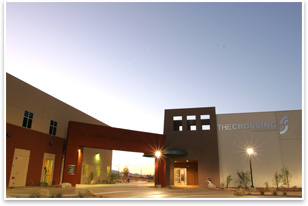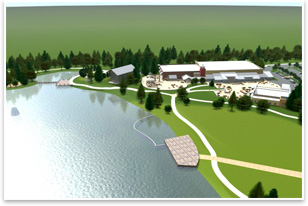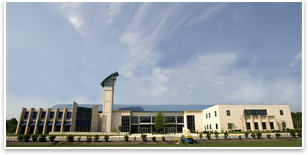| Worship Centers Create Town Center Atmosphere
by Russell Boniface
Associate Editor
 Summary: Community-oriented worship centers that resemble town centers are becoming more prevalent among Protestant denominations across the country. An average-sized worship center seats approximately 1,500 persons. In cases where seating capacity is as large as 2,000 plus, such as the Corona Christian Church in Irving, Calif., the structures are labeled mega-churches. Willow Creek Community Church in South Barrington, Ill., seats 18,000. In addition to worship space, the worship centers and mega-churches offer a wide range of life-care and recreation activities that can include schools, child care, counseling centers, computer-learning centers, job retraining services, basketball courts, baseball fields, aerobic and dance studios, and lounges. Retail can also be present in some worship centers—for example, coffee bars, private restaurants, and large cafeterias—that may operate as a separate corporation and would pay municipal taxes. The design goal for the worship center is to create a mixed-use, “worshipful” center that allows people to feel comfortable and relaxed so they interact in capacities beyond the actual worship service. Summary: Community-oriented worship centers that resemble town centers are becoming more prevalent among Protestant denominations across the country. An average-sized worship center seats approximately 1,500 persons. In cases where seating capacity is as large as 2,000 plus, such as the Corona Christian Church in Irving, Calif., the structures are labeled mega-churches. Willow Creek Community Church in South Barrington, Ill., seats 18,000. In addition to worship space, the worship centers and mega-churches offer a wide range of life-care and recreation activities that can include schools, child care, counseling centers, computer-learning centers, job retraining services, basketball courts, baseball fields, aerobic and dance studios, and lounges. Retail can also be present in some worship centers—for example, coffee bars, private restaurants, and large cafeterias—that may operate as a separate corporation and would pay municipal taxes. The design goal for the worship center is to create a mixed-use, “worshipful” center that allows people to feel comfortable and relaxed so they interact in capacities beyond the actual worship service.
Waldon Studio Architects & Planners in Columbia, Md., has designed several community-oriented worship centers that seat from 300-1,500. The firm has collaborated on many worship centers with Irving, Calif.-based Visioneering Studios, which specialize in mega-churches.
Mixed-use design invites community to a comfortable place
“Communities are looking at the worship center concept as being a place to go,” says Ravi Waldon, AIA, president of Waldon Studio Architects & Planners. “It’s much like the old village, where the church used to be in the center of town. It’s trying to offer whole, life-care activities. The challenge is designing a multipurpose center that makes a utilitarian space feel worshipful. That means different things to people. The question needs to be: What will be its different uses? The design should be eye-catching and make people want to visit.”
 Waldon says the worship center is an assembly building with non-separated mixed uses. “They get started with the vision to reach the community. The term would be a seeker-friendly church, comfortable to go to. Many times, especially on the Protestant and Evangelical side, there is a lot of effort not to feel ‘churchy;’ not to design a center-axial church but instead, most always, a fan-shaped design.” Waldon says the worship center is an assembly building with non-separated mixed uses. “They get started with the vision to reach the community. The term would be a seeker-friendly church, comfortable to go to. Many times, especially on the Protestant and Evangelical side, there is a lot of effort not to feel ‘churchy;’ not to design a center-axial church but instead, most always, a fan-shaped design.”
Mixed uses can include schools, day care, coffee bars and lounges, basketball courts, soccer and baseball fields, aerobic and dance studios, counseling and computer centers, restaurants, and performance halls. “They want people to linger,” Waldon points out. “The assembly space can even be converted into performance space or a basketball court. A lot of churches have performance and dance that support the message communicated that day. The architect has to be sensitive to that.” Waldon adds that the worship style is media-oriented with video and technology, such as television screens. “But the intent is that it doesn’t become dominant in one space. Keep it in balance.”
Organized themes abound
Both Waldon Studios and Visioneering Studios have collaborated on several church projects around organized themes. The design is set in the context of the overall site plan, says Waldon. While Northeast Christian Church in Louisville, Ky., has a main street design, Heritage Christian Church in Fayetteville, Ga., is designed with the idea of the Georgia State Parks and includes a lake, Georgia Pines, and campground. The Northside Church in Texas actually suggests the wildness of Western towns in casual forms, almost like an old cowboy town, and is based on a crescent of trees.
Spaces are frequently departmentalized by different uses, Waldon adds, often by age group. “When you have a lot of people in the building, you keep the population separate and secure by defining and designing spaces by age group. For example, only parents can go in the nursery.” With all the different activities being offered for all age groups, Waldon says the user experience becomes generational. “For somebody who is 25, this may be the only thing they have ever known that feels worshipful.”
Waldon explains that churches are buying enough land to house the capability, so zoning is not an issue. “They are a church facility and have mixed uses, but they are an assembly building with non-separated mixed use, so they are allowed to have a lot of by-zoning because it’s all the ministry of the church. But when they start having an actual five-day school or a child-care center, then other zoning regulations kick in, and they have to satisfy those regulations.“
 Worship centers go beyond the whole worship experience, says Michael Crosbie, AIA, chair of the Architecture Department at the University of Hartford and editor of Faith and Form magazine. “Worship in these places is not traditionally what you’d imagine worship to be if you were raised in a Catholic tradition—there’s no liturgy and sacrament. There’s a lot of music and stirring oratory, more in the vain of the American non-specific Protestant denomination. The denominations tend to be more Evangelical, Pentecostal, and Methodist.” Worship centers go beyond the whole worship experience, says Michael Crosbie, AIA, chair of the Architecture Department at the University of Hartford and editor of Faith and Form magazine. “Worship in these places is not traditionally what you’d imagine worship to be if you were raised in a Catholic tradition—there’s no liturgy and sacrament. There’s a lot of music and stirring oratory, more in the vain of the American non-specific Protestant denomination. The denominations tend to be more Evangelical, Pentecostal, and Methodist.”
Mega-churches
Mega-churches are worship centers with seating capacity that can reach 18,000. The McLean Bible Church in McLean Va., features a large orchestra and entire wing for autistic children and seats 8,000. The biggest one in the country, Willow Creek Community Church in South Barrington, Ill., seats 18,000 people and has an entire food service division to serve meals. Waldon points out that the term mega-church is more of an attitude of being seeker-friendly. “It’s not just about the size but about the approach to design.”
Visioneering Studios president Mel McGowan says that the “official“ definition of a mega-church is a congregation that has 2,000-plus attendees per week. Many are in the suburbs and have a regional town center design. “In the old days everyone in the town went to one church,” says McGowan. “What has happened is the church architecture has paralleled suburban migration, following big-box retail and malls. The model is anywhere from a 20–100 acre campus and looks more secular and less sacred, almost as if to not scare someone away. There is a lot of effort to make it look like a community college or corporate campus.”
McGowan underscores the idea of organized themes. Visioneering designed Crossroads Christian Church in Corona, Calif., which seats 3,200 seats and is organized around a plaza. Crossroads has a worship space that is also used for civic events, plus shops and restaurants. The Crossing in Las Vegas has a portal that evokes a Middle Eastern town gate. Says McGowan: “The Crossing utilizes architecture of impermanence using metal siding and fabric canopies to evoke the Israelite’s 40-year journey through the desert wilderness before reaching the Promised Land.”
He adds that more of his firm’s projects are being designed in cities, as part of the boom in urban revitalization. Visioneering has a conceptual rendering for a mixed-use, transit-oriented, 3,500-seat church for south Los Angeles that will have a National Football Stadium, a Cineplex, and a performing arts center.
 “The focus of our practice is the younger generation who are swinging away from that modernist function,” McGowan says. ”We aim for an intimate, authentic communal environment with a faith-based sacred component. Biblically, the word church doesn’t refer to buildings, but rather the assembly of people. The old mega-church model was a functional campus, one-day per week, empty the other six days. People are coming around to the notion that it’s not the best use of land. In our practice, we are plugging into mixed-use components.” “The focus of our practice is the younger generation who are swinging away from that modernist function,” McGowan says. ”We aim for an intimate, authentic communal environment with a faith-based sacred component. Biblically, the word church doesn’t refer to buildings, but rather the assembly of people. The old mega-church model was a functional campus, one-day per week, empty the other six days. People are coming around to the notion that it’s not the best use of land. In our practice, we are plugging into mixed-use components.”
In some cases, churches are looking to history and European churches, he adds. “The churches are realizing that throughout Western civilization, the church was always the anchor of the community, instead of being off on its own. When you look at the European model, its pedestrian mixed-use in a piazza, with the church, a café, and residential uses on top of some stores. So, we want the churches to be plugged in as a community center, with different uses such as meeting facilities, sports facilities, after-school education—you name it.”
Retail space is made available to the community, similar to other mixed-use projects, where private businesses own, operate, and lease space and are subject to sales and property tax. “If it’s a private business, it’s a separate corporation,” says Waldon. “If the church is running a school, the school might be a separate entity or a ministry of the church. The church makes that decision. It’s driven by who is funding what.”
Not a one-day experience
Crosbie says the mega-churches serve as a way of living that’s not just one day of going to church. “It’s an embracement of you and your life. The original mega-church, Willow Creek, actually started with a car repair component. Many of these places now offer counseling for life-challenging issues. I think there are certain faith groups, primarily Protestant, where this is really part of the life you are living, where you are doing this in communion and community with fellow believers.
“Traditional worship— going to temple Saturday or going to church on Sunday—was a one-day experience,” Crosbie notes. “The mega-church notion has embraced living your faith day to day.” |


 Summary:
Summary:


